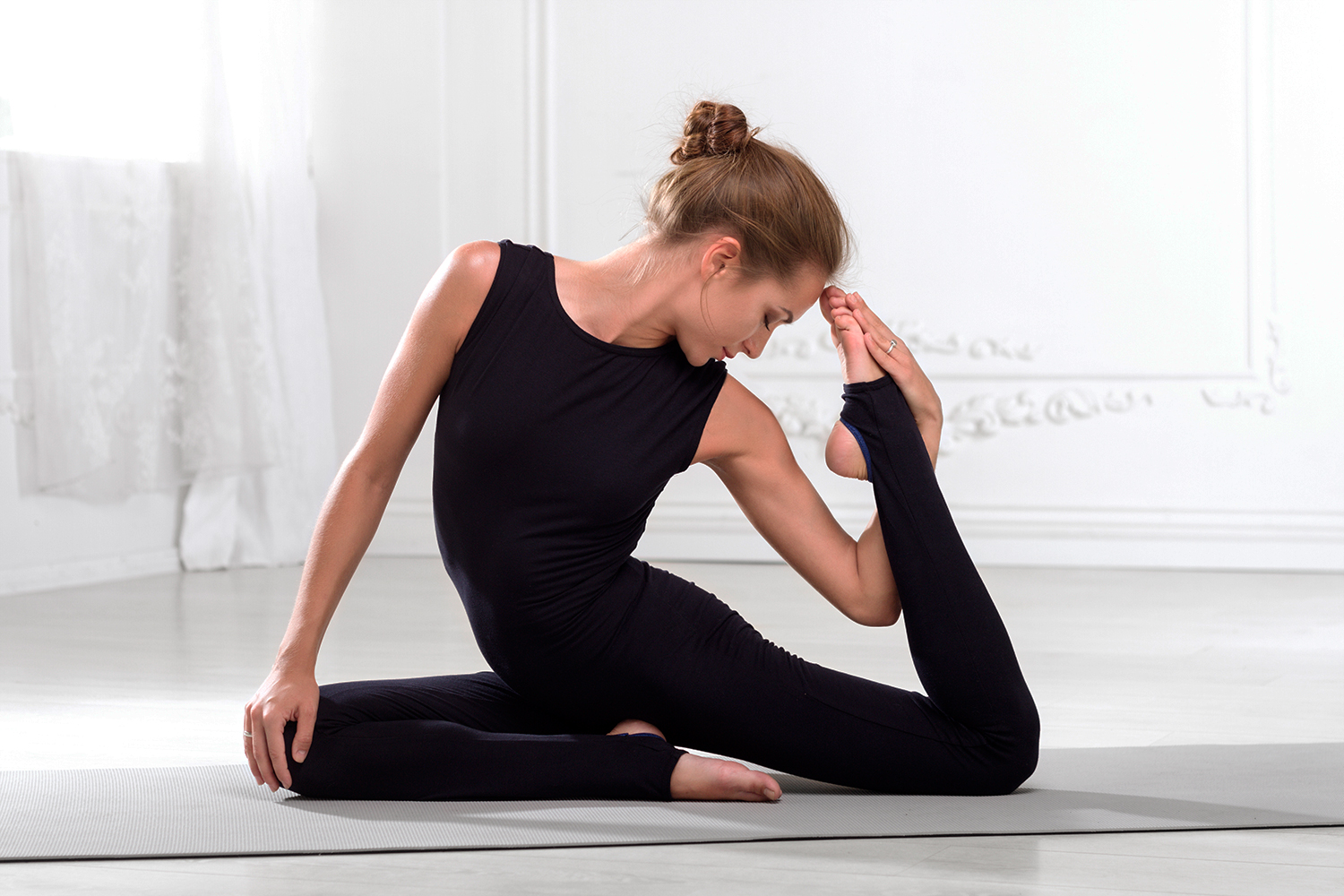
Having been a teacher’s assistant at over 50 yoga teacher…
It takes real work to be healthy in the modern world. We are presented with challenges that stress us out every day, multiple times a day. While you may not be able to escape this reality, you are able to rewrite your story through yoga and meditation. Specific breath techniques, postures, and mindfulness practices can completely change the way your body responds to challenges and stressors that are out of your control. You can reprogram your stress response, mental activity, digestion, sleep and emotions, all on your mat. With consistent practice, you will improve your entire life!
Change Your Stress Response

The fight or flight response in the body is an acute stress response that happens when we are threatened in some way, either mentally or physically. This triggers the sympathetic nervous system to stimulate the adrenals, releasing hormones to increase our heart rate, blood, pressure, and breath. Physiologically, we are preparing to fight or flee. While this response is automatic, it often happens when there is no real threat or immediate danger.
Unfortunately, these physical manifestations can perpetuate unnecessary panic, stress, and anxiety in the body. Chronic stress overtime can lead to illnesses like nervous system disorders, hormonal imbalances, and immune conditions. While we may not be threatened by saber toothed tigers anymore, we encounter metaphorical “predators” every day. To name a few, sitting in traffic, running late, having an argument, public speaking, watching a scary movie, and being overworked can all trigger your sympathetic nervous system.
To counteract the fight or flight response, the parasympathetic nervous system must be activated. This is the “rest and digest” part of the autonomic nervous system, which conserves energy by slowing down bodily functions.
Yoga For Stress

Yoga and meditation are key to activating the parasympathetic nervous system and reducing stress in the body. By consciously being aware of your surroundings, body, mind, and breath, you are able to take control of the body’s natural response to stress and actually change it!
This simple meditation technique can help you release tension:
Sit in a comfortable position in a chair or on your mat, or lay down with your eyes closed.
Become aware of your breath. As you breathe in slowly and deeply, expand your belly and chest. As you exhale, relax every muscle of the body. Practice this for 1 minute.
With your mind’s eye, pay attention to your feet. Notice the qualities of both feet, and intentionally relax those muscles.
Move your awareness up to your legs, noticing any sensations that are present. Relax your legs.
Continue to scan the rest of the body like this and soften these areas, going all the way up to the face and head.
Any type of gentle, restorative yoga is great for relaxation and stress relief, too. Take a restorative class, or create a sequence of your own using the following postures, and practice each asana for 5 minutes at a time:
Balasana – Child’s Pose
Supta Baddha Konasana – Reclining Bound Angle Pose
Viparita Karani – Legs Up the Wall Pose
Savasana – Corpse Pose
Connect Your Mind and Body

Thoughts and feelings actually carry physical vibrations that influence our bodies on a cellular level. According to the Chopra Center, “Science demonstrates that thoughts, words, and feelings can change the crystal structure of water and cells.” Emotions are felt differently in various parts of the body. When you feel nervous, you may get butterflies in your belly. If you are excited or overjoyed, you may feel more sensation in your chest or heart center. Sometimes, you may even get a lump in your throat if you feel scared or inhibited in some way. This connection is a two way street, as your emotions and thoughts influence your body, and your body influences them in turn.
Meditation Exploration

Consciously understanding how the body is affected by emotions is vital to mastering any meditation practice. Meditation helps clear the clutter in your mind, and it can filter thoughts that are true facts from those that are untrue. Meditation also allows you to perceive emotions as feelings you have, versus feelings that you are. It allows you to see that feelings are a temporary state of being. This helps you compartmentalize.
Try a simple pranayama called dirga breath, also known as three part breath:
Sit in a comfortable position on your mat with your eyes closed. Place one hand on your belly.
As you inhale, focus on expanding your belly into your hand. As you exhale, allow your belly to come back towards the spine. Repeat 5 times.
Move your hand to the side of your ribs. Inhale, and feel your ribs open into your hand. As you exhale, notice your ribs fall back to the belly. Repeat 5 times.
Lastly, place your hand on your chest. As you inhale, breath into the chest and expand the lungs. On the exhale, relax your thorax. Repeat 5 times.
Continue to expand the belly, ribs and chest for 10 breaths. Every inhale and exhale should last 4 seconds or more.
Yoga for Concentration

The best yoga postures for a centered mind are balancing asanas. To balance, your mind must be clear. If your thoughts are scattered and unfocused, your physical body will surely feel the same. Before beginning any balancing pose, you need to find your drishti. This is a gazing technique that will help you concentrate and balance successfully. Fix your eyes on an unmoving point, such as a spot on the wall in front of you. Keep your eyes glued to this object as you move into a posture. When you lose focus of your drishti, you may find that your body loses balance quickly.
Begin with simple asanas and balance on each leg for at least 10 breaths:
Vrksasana – Tree Pose
Garudasana – Eagle Pose
Virabhadrasana III – Warrior III Pose
Improve Your Digestion

Your gut is one of the most important components of good health. Your gastrointestinal system is often called your body’s second brain for a reason!
All disease begins in the gut. Hippocrates
The way you digest food and the level of bacteria in your gut flora is linked to mineral absorption, hormone regulation, vitamin production, immune response, toxin elimination, and mental health. Having an unhealthy gut biome can be caused by overuse of drugs and antibiotics, stress, eating habits, and other environmental factors. If you are not digesting your food, your body won’t be able to absorb minerals and nutrients properly, causing a whole range of GI and health problems.
How Does Digestion Affect Us?
An unbalanced gastrointestinal tract can cause mental health issues such as depression and anxiety. It can also influence our immune response, triggering allergies and even autoimmune disorders. Poor digestion and gut health causes widespread inflammation throughout the body. The best way to counteract a poor digestive system is first to see a practitioner who is well versed in gut health. Your diet is also extremely important, and the more natural foods you eat the better you will feel.
Yoga for Better Digestion

Yoga can also help you reprogram your digestion. Certain postures can reduce gas, bloating and constipation, while also increasing your energy level. Deep breathing and stretching that target the abdominal organs are the best for digestion.
Massaging the abdominals with a twist is a gentle way to move things along. Try these twisting postures and hold them for 1 minute on each side:
Supta Matsyendrasana – Supine Twist Pose
Parivrtta Trikonasana – Revolved Triangle Pose
Postures that also extend the spine can help with digestion help your gastrointestinal tract flow. Other asanas that gently compress your belly can be helpful as well if you are having tummy troubles. Try these postures and hold them for 10 breaths:
Setu Bandha Sarvangasana – Bridge Pose
Ardha Pawanmuktasana – Half Wind Release Pose
Balasana – Child’s Pose
Because stress can also influence your digestion, it is important to find time to meditate or at least rest in a peaceful way. Always take savasana after any yoga practice for at least 5 minutes to unwind.
Sleep Deeper

50 – 70 million adults in the United States have a sleep disorder. Disorders include, insomnia, sleep deprivation, oversleeping, and sleep apnea. Insomnia is the most common, and it affects roughly 30% of people. The most common causes of insomnia are medical conditions, unhealthy sleep habits, stress, biological factors, and use of substances. Some of us have trouble falling asleep, while others have trouble staying asleep. Whatever your issue might be, it is first important to speak with a medical professional if you are having severe sleep issues.
How Does Sleep Affect Us?
Sleep is so important, and without it, we would not be able to function at all. Biologically, if we suffer from chronic sleep deprivation, it increases the risk of disorders such as high blood pressure, cardiovascular disease, obesity, depression, and diabetes. Most of us need 7 – 9 hours of sleep per night. Younger children and teenagers need more, while older adults may need less. When we get a good night’s rest, we are more likely to wake up feeling refreshed, happier, and more alert.
In general, it is recommended to avoid alcohol and caffeine before bed, and not to take any of these substances that interfere with sleep in excess during the day. Exercise also helps, as well as keeping a consistent sleep schedule if possible.
Yoga for Sleep

Yoga and meditation can greatly assist in reprogramming your sleep patterns, especially if you have insomnia. Any type of restorative yoga is excellent to do before bed. You can even do it while you are in bed! Here are 5 excellent postures to practice for better and deeper sleep:
Take Child’s Pose (Balasana) with a pillow under your belly. Turn your cheek to one side and spend at least 2 minutes deeply breathing in this posture.
Do Supine Twist (Supta Matsyendrasana) for 2 minutes on each side. Again, breathe deeply and slowly to calm down your central nervous system.
Take Seated Forward Bend (Paschimottanasana) for at least 2 minutes. Stack pillows or blankets on top of your legs to make this a passive stretch.
Perform Thread The Needle Pose (Parsva Balasana) for 1 minute on each side. This restorative shoulder opener will help relax and release tension in the neck and back.
Do Bound Angle Pose (Baddha Konasana) for 1-2 minutes. Place a block under your forehead to rest and balance passively.
If you can get to a yoga class or listen to a guided audio recording, try yoga nidra. This is a powerful relaxation meditation that shifts your brain waves and rejuvenates your entire being.
Balance the Limbic System

The limbic system is located in the brain, atop the brain stem. This mechanism controls emotions, hunger, pain, sexual desire, the autonomic nervous system, certain memories, and the senses. It is the primary operator of our “animal” brain, and one that all mammals share in common. The limbic system is primarily comprised of the hippocampus, amygdala, and the hypothalamus. It is located on both sides of the thalamus and underneath the cerebrum. Because this system of glands and organs in the brain controls our autonomic nervous system, it is also in charge of our stress response.
How Do We Influence the Limbic System?
The goal of the brain is to find balance in all systems. The autonomic nervous system, comprised of the parasympathetic and sympathetic nervous systems, needs to operate in homeostasis to maintain optimal health. Because of stress internally and from the outside environment, our entire limbic system can be thrown off balance. This can make everything in the hypothalamus, hippocampus, and amygdala irregular, such as hormone production, hunger levels, emotions, cognitive functions, and decision making.
Yoga To The Rescue

Yoga is one of the ways that we can reprogram our limbic system and find that optimal balance that is required for good health. The first task is to breathe!
Start by lying on your back either in bed or on your yoga mat.
As you inhale, expand the lungs into the chest, ribs and belly.
Hold your breath for 5 seconds, and exhale slowly and smoothly.
Continue to inhale, hold the breath, and exhale at a steady pace. Practice this breath for 10 minutes to completely rewire your breathing patterns and stress levels.
If you are a more auditory learner and sound helps you focus, listening to a guided meditation is also another excellent way to rebalance your limbic system.
The best yoga postures for your limbic system are ones that are passive and relaxing. Try each of the following postures for at least 1 minute:
Matsyasana – Fish Pose
Anahatasana – Melting Heart Pose
Upavistha Konasana – Wide Angle Seated Forward Bend
Begin Your Journey

Yoga isn’t just about stretching or fitness. You can actually reprogram your entire body, and therefore, your entire life by practicing regularly and with intention. Specific postures, breath techniques, meditation, and styles of yoga can positively influence your stress response, emotions, digestive system, sleep patterns, and limbic system. What’s even better, you don’t even have to attend a yoga class to do this! You can start from where you are right now. Take control of your health today. Do it for yourself and your wellbeing!
What's Your Reaction?
Having been a teacher’s assistant at over 50 yoga teacher trainings worldwide, Rebecca Rebecca has a firm grasp on the fine art of yoga and meditation. In her work, she carefully reflects on a vast expanse of knowledge to help others find peace in both body and mind.














